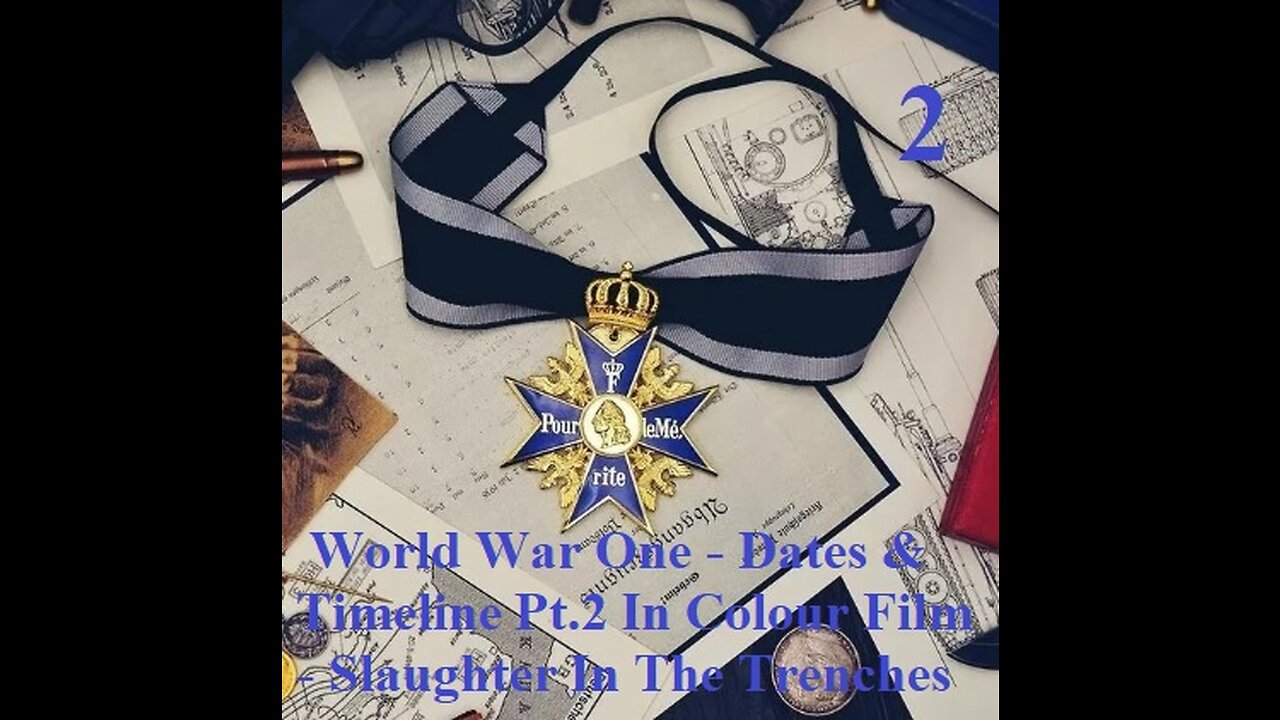Premium Only Content

World War One - Dates & Timeline Pt. 2 In Colour Film - Slaughter In The Trenches
World War I Pitted Germany, Austria-Hungary and the Ottoman Empire against Great Britain, the United States, France, Russia, Italy and Japan. New military technology resulted in unprecedented carnage. By the time the war was over and the Allied Powers claimed victory, more than 16 million people—soldiers and civilians alike—were dead. Pt. 2 of Seven.
1. It was a global war
Over 30 nations declared war between 1914 and 1918. The majority joined on the side of the Allies, including Serbia, Russia, France, Britain, Italy and the United States. They were opposed by Germany, Austria-Hungary, Bulgaria and the Ottoman Empire, who together formed the Central Powers. What began as a relatively small conflict in southeast Europe became a war between European empires. Britain and its Empire’s entry into the war made this a truly global conflict fought on a geographical scale never seen before. Fighting occurred not only on the Western Front, but in eastern and southeast Europe, Africa and the Middle East.
2. It is Far Better to Face the Bullets...
The First World War was not inevitable or accidental, but began as a result of human actions and decisions.
Over 65 million men volunteered or were conscripted to fight in mass citizen armies. Millions of civilians also contributed to the war effort by working in industry, agriculture or jobs left open when men enlisted. Victory depended on popular support. Some nations were forced to surrender as their people, pushed to their physical and emotional limits, lost the will to continue fighting. The First World War was also a war against people. Invading armies committed atrocities against civilians in the areas they occupied. Attacks on civilians became increasingly common as each nation tried to break their opponents’ home morale and diminish popular support for the war. Propaganda demonised entire nations and attacked the ‘national characters’ of enemy peoples.
3. It was a war of production
National resources were mobilised as each combatant nation raced to supply its armed forces with enough men and equipment.
In Britain, early failures in munitions manufacturing led to full government intervention in war production. These controls helped its industry produce nearly 4 million rifles, 250,000 machine guns, 52,000 aeroplanes, 2,800 tanks, 25,000 artillery pieces and over 170 million rounds of artillery shells by 1918.
4. It was a war of innovation
Advances in weaponry and military technology provoked tactical changes as each side tried to gain an advantage over the other. The introduction of aircraft into war left soldiers and civilians vulnerable to attacks from above for the first time.
Major innovations were also made in manufacturing, chemistry and communications. Medical advances made the First World War the first major conflict in which British deaths in battle outnumbered deaths caused by disease.
5. It was a war of destruction
The First World War left an estimated 16 million soldiers and civilians dead and countless others physically and psychologically wounded. The war also forever altered the world’s social and political landscape. It accelerated changes in attitudes towards gender and class and led to the collapse of the Russian, Austro-Hungarian and Ottoman empires. The cost of waging total war - and of rebuilding afterwards - ravaged the national economies of both the victorious European Allies and the defeated Central Powers.
The human cost of the First World War for Britain saw the creation of a new language of remembrance, which remains to this day. It can be seen in war memorials in cities, towns, schools, places of worship and workplaces, as well as in rituals such as Remembrance Sunday and the two-minute silence at 11am each 11 November.
World War I Begins
At the dawn of the 20th century, few anticipated a global war, but what came to be known as the Great War began on June 28, 1914, with the assassinations of Austrian Archduke Franz Ferdinand and his wife, Sophie, while they were visiting Sarajevo, Bosnia, a country recently annexed into the Austrian Empire. Many Bosnians and their Serbian neighbors resented this foreign rule and the Archduke’s visit to Sarajevo provided the opportunity for a small band of Serbian dissidents to strike back. Austria responded to the assassinations by teaming up with its ally, Germany, and declaring war on Serbia. The conflict soon involved Russia, France and Belgium. Fearful of a full-scale world war that would threaten its sea routes to other countries, Great Britain joined the fight against Germany and Austria.
Each country believed the fighting would last only a few months. Nations were categorized either as Central Powers or Allies. Countries that joined the Central Powers, such as Bulgaria and the Ottoman Empire, supported Austria-Hungary and Germany. The Allies were Russia, France, Belgium and Great Britain, but they were later joined by Japan, Romania, China and the United States.
No Man’s Land: Trench Warfare
During World War I, trench warfare was a defensive military tactic used extensively by both sides, allowing soldiers some protection from enemy fire but also hindering troops from readily advancing and thus prolonging the war. Trench warfare was the major combat tactic in France and Belgium. Trenches were often dug up to 12 feet deep and stretched for miles. For stability, some trenches included wooden beams and/or sandbags. Even during lulls in the fighting, death occurred almost daily in the trenches due to a sniper’s bullet or the unsanitary living conditions which resulted in many diseases such as dysentery, typhus and cholera. Other diseases caused by the poor conditions were trench mouth and trench foot*.
*Trench mouth was an infection of the mouth due to overgrowth of certain oral bacteria. The condition was made worse by poor oral hygiene, smoking, malnutrition and psychological stress. To prevent trench foot, a fungal disease caused by exposure to wet and cold, soldiers frequently added wooden planks in the trenches to keep from having to stand in water.
Barbed wire and explosive mines—as well as bullets and grenades—were essential weapons used to hinder infantry advances across “No Man’s Land,” the bleak landscape between the trenches of the opposing sides.
New offensive weapons were implemented during the war including tanks and poison gases*.
*Tanks, armored against artillery fire, were capable of rolling over barbed wire as well as crossing treacherous terrain.
Chlorine was one of the poisonous gases used in World War I. It was damaging to the eyes, nose, throat and lungs, and produced symptoms ranging from irritation to blindness and death.)
In 1915, the Germans used poison gases against the Allies fighting in the trenches on the Western Front. To protect soldiers from chemical warfare, gas masks were developed. Great Britain made one of the first types of masks capable of minimizing the deadly impact of these gases on their troops.
Though considered a novelty when the war began, aircraft were used by both sides for reconnaissance, allowing personnel to observe enemy troop positions, to direct artillery fire and to photograph enemy lines. By the end of the war, the concepts of aerial combat and aerial bombing had come into being.
See Part One - World War One - Dates & Rest Of Timeline Info. Text 1914 Thur 1916 Thanks.
January 19, 1917 - The British intercept a telegram sent by Alfred Zimmermann in the German Foreign Office to the German embassies in Washington, D.C., and Mexico City. Its message outlines plans for an alliance between Germany and Mexico against the United States. According to the scheme, Germany would provide tactical support while Mexico would benefit by expanding into the American Southwest, retrieving territories that had once been part of Mexico. The Zimmermann telegram is passed along by the British to the Americans and is then made public, causing an outcry from interventionists in the U.S., such as former president Teddy Roosevelt, who favor American military involvement in the war.
February 1, 1917 - The Germans resume unrestricted submarine warfare around the British Isles with the goal of knocking Britain out of the war by cutting off all imports to starve the British people into submission.
February 3, 1917 - The United States severs diplomatic ties with Germany after a U-Boat sinks the American grain ship Housatonic. Seven more American ships are sunk in February and March as the Germans sink 500 ships in just sixty days.
February 25, 1917 - In the Middle East, newly reinforced and replenished British troops retake Kut al-Amara in Mesopotamia from outnumbered Turks. The British then continue their advance and capture Baghdad, followed by Ramadi and Tikrit.
Russian Revolution
March 8, 1917 - A mass protest by Russian civilians in Petrograd (St. Petersburg) erupts into a revolution against Czar Nicholas II and the war. Within days, Russian soldiers mutiny and join the revolution.
March 15, 1917 - The 300-year-old Romanov dynasty in Russia ends upon the abdication of Czar Nicholas II. In his place, a new democratically minded Provisional Government is established. Great Britain, France, the United States, and Italy rush to recognize the new government in the hope Russia will stay in the war and maintain its huge presence on the Eastern Front.
March 15, 1917 - Germans along the central portion of the Western Front in France begin a strategic withdrawal to the new Siegfried Line (called the Hindenburg Line by the Allies) which shortens the overall Front by 25 miles by eliminating an unneeded bulge. During the three-week long withdrawal, the Germans conduct a scorched earth policy, destroying everything of value.
April 1917 - British combat pilots on the Western Front suffer a 50 percent casualty rate during Bloody April as the Germans shoot down 150 fighter planes. The average life expectancy of an Allied fighter pilot is now three weeks, resulting from aerial dogfights and accidents.
America Enters
April 2, 1917 - President Woodrow Wilson appears before the U.S. Congress and gives a speech saying "the world must be made safe for democracy" then asks the Congress for a declaration of war against Germany.
April 6, 1917 - The United States of America declares war on Germany.
April 9, 1917 - The British Army has one of its most productive days of the war as 3rd Army, supported by Canadian and Australian troops, makes rapid advances north of the Hindenburg Line at Arras and Vimy on the Western Front. The expansive first-day achievement in snowy weather includes a 3.5 mile territorial gain and the capture of Vimy Ridge by Canadians. However, similar to past offensives, the inability to capitalize on initial successes and maintain momentum gives the Germans an opportunity to regroup and further gains are thwarted. The British suffer 150,000 casualties during the offensive, while the Germans suffer 100,000.
Nivelle Offensive
April 16, 1917 - The French 5th and 6th Armies attack along a 25-mile front south of the Hindenburg Line. The new offensive comes amid promises of a major breakthrough within 24-hours by the new French Commander-in-Chief, Robert Nivelle, who planned the operation. Nivelle once again utilizes his creeping barrage tactic in which his armies advance in stages closely behind successive waves of artillery fire. However, this time it is poorly coordinated and the troops fall far behind. The Germans also benefit from good intelligence and aerial reconnaissance and are mostly aware of the French plan. Nivelle's offensive collapses within days with over 100,000 casualties. French President Poincaré personally intervenes and Nivelle is relieved of his command. He is replaced as Commander-in-Chief by General Henri Petain, who must deal with a French Army that is now showing signs of mutiny.
April 16, 1917 - Political agitator Vladimir Lenin arrives back in Russia, following 12 years of exile in Switzerland. Special train transportation for his return was provided by the Germans in the hope that anti-war Lenin and his radical Bolshevik Party will disrupt Russia's new Provisional Government. Lenin joins other Bolsheviks in Petrograd who have already returned from exile including Joseph Stalin.
May 18, 1917 - The Selective Service Act is passed by the U.S. Congress, authorizing a draft. The small U.S. Army, presently consisting of 145,000 men, will be enlarged to 4,000,000 via the draft.
May 19, 1917 - The Provisional Government of Russia announces it will stay in the war. A large offensive for the Eastern Front is then planned by Alexander Kerensky, the new Minister of War. However, Russian soldiers and peasants are now flocking to Lenin's Bolshevik Party which opposes the war and the Provisional Government.
French Mutiny
May 27-June 1, 1917 - The mutinous atmosphere in the French Army erupts into open insubordination as soldiers refuse orders to advance. More than half of the French divisions on the Western Front experience some degree of disruption by disgruntled soldiers, angry over the unending battles of attrition and appalling living conditions in the muddy, rat and lice-infested trenches. The new Commander-in-Chief, Henri Petain, cracks down on the mutiny by ordering mass arrests, followed by several firing squad executions that serve as a warning. Petain then suspends all French offensives and visits the troops to personally promise an improvement of the whole situation. With the French Army in disarray the main burden on the Western Front falls squarely upon the British.
June 7, 1917 - A tremendous underground explosion collapses the German-held Messines Ridge south of Ypres in Belgium. Upon detonation, 10,000 Germans stationed on the ridge vanish instantly. The British then storm the ridge forcing the surviving Germans to withdraw to a new defensive position further eastward. The 250-foot-high ridge had given the Germans a commanding defensive position. British, Australian and Canadian tunnelers had worked for a year to dig mines and place 600 tons of explosives.
June 13, 1917 - London suffers its highest civilian casualties of the war as German airplanes bomb the city, killing 158 persons and wounding 425. The British react to the new bombing campaign by forming home defense fighter squadrons and later conduct retaliatory bombing raids against Germany by British planes based in France.
June 25, 1917 - The first American troops land in France.
July 1, 1917 - Russian troops begin the Kerensky Offensive attempting to recapture the city of Lemberg (Lvov) on the Eastern Front. The Germans are lying in wait, fully aware of the battle plans which have been leaked to them. The Russians attack along a 40-mile front but suffer from a jumble of tactical problems including a lack of artillery coordination, poor troop placement, and serious disunity within the ranks reflecting the divisive political situation back home. The whole offensive disintegrates within five days. Sensing they might break the Russian Army, the Germans launch a furious counter-offensive and watch as Russian soldiers run away.
July 2, 1917 - Greece declares war on the Central Powers, following the abdication of pro-German King Constantine who is replaced by a pro-Allied administration led by Prime Minister Venizelos. Greek soldiers are now added to the Allied ranks.
Third Battle of Ypres
July 31-November 6, 1917
July 31, 1917 - The British attempt once more to break through the German lines, this time by attacking positions east of Ypres, Belgium. However, by now the Germans have vastly improved their trench defenses including well-positioned artillery. Although the British 5th Army succeeds in securing forward trench positions, further progress is halted by heavy artillery barrages from the German 4th Army and rainy weather.
August 10, 1917 - The British resume their attack at Ypres, focusing on German artillery positions around Gheluvelt. The attack produces few gains as the Germans effectively bombard and then counter-attack. Six days later, the British try again, with similar results. The entire Ypres offensive then grinds to a halt as British Army Commander Douglas Haig ponders his strategy.
September 1, 1917 - On the Eastern Front, the final Russian battle in the war begins as the Germans attack toward Riga. The German 8th Army utilizes new storm troop tactics devised by General Oskar von Hutier. Bypassing any strong points as they move forward, storm troop battalions armed with light machine-guns, grenades and flame throwers focus on quickly infiltrating the rear areas to disrupt communications and take out artillery. The Russian 12th Army, under General Kornilov, is unable to hold itself together amid the storm troop attacks and abandons Riga, then begins a rapid retreat along the Dvina River, pursued by the Germans.
September 20, 1917 - A revised British strategy begins at Ypres designed to wear down the Germans. It features a series of intensive, narrowly focused artillery and troop attacks with limited objectives, to be launched every six days. The first such attack, along the Menin Road toward Gheluvelt, produces a gain of about 1,000 yards with 22,000 British and Australian casualties. Subsequent attacks yield similar results.
October 12, 1917 - The Ypres offensive culminates around the village of Passchendaele as Australian and New Zealand troops die by the thousands while attempting to press forward across a battlefield of liquid mud, advancing just 100 yards. Steady October rains create a slippery quagmire in which wounded soldiers routinely drown in mud-filled shell craters.
Attack at Caporetto
October 24, 1917 - In northern Italy, a rout of the Italian Army begins as 35 German and Austrian divisions cross the Isonzo River into Italy at Caporetto and then rapidly push 41 Italian divisions 60 miles southward. By now, the Italians have been worn down from years of costly but inconclusive battles along the Isonzo and in the Trentino, amid a perceived lack of Allied support. Nearly 300,000 Italians surrender as the Austro-Germans advance, while some 400,000 desert. The Austro-Germans halt at the Piave River north of Venice only due to supply lines which have become stretched to the limit.
October 26, 1917 - At Ypres, a second attempt is made but fails to capture the village of Passchendaele, with Canadian troops participating this time. Four days later, the Allies attack again and edge closer as the Germans slowly begin pulling out.
October 31, 1917 - In the Middle East, the British led by General Edmund Allenby begin an attack against Turkish defensive lines stretching between Gaza and Beersheba in southern Palestine. The initial attack on Beersheba surprises the Turks and they pull troops away from Gaza which the British attack secondly. The Turks then retreat northward toward Jerusalem with the Allies in pursuit. Aiding the Allies, are a group of Arab fighters led by T. E. Lawrence, an Arab speaking English archeologist, later known as Lawrence of Arabia. He is instrumental in encouraging Arab opposition to the Turks and in disrupting their railroad and communication system.
November 6, 1917 - The village of Passchendaele is captured by Canadian troops. The Allied offensive then ceases, bringing the Third Battle of Ypres to an end with no significant gains amid 500,000 casualties experienced by all sides.
October Revolution
November 6-7, 1917 - In Russia, Bolsheviks led by Vladimir Lenin and Leon Trotsky overthrow the Provisional Government in what comes to be known as the October Revolution (Oct. 24-25 according to the Russian calendar). They establish a non-democratic Soviet Government based on Marxism which prohibits private enterprise and private land ownership. Lenin announces that Soviet Russia will immediately end its involvement in the war and renounces all existing treaties with the Allies.
November 11, 1917 - The German High Command, led by Erich Ludendorff, gathers at Mons, Belgium, to map out a strategy for 1918. Ludendorff bluntly states he is willing to accept a million German casualties in a daring plan to achieve victory in early 1918, before the American Army arrives in force. The goal is to drive a wedge between the British and French armies on the Western Front via a series of all-out offensives using Germany's finest divisions and intensive storm troop tactics. Once this succeeds, the plan is to first decimate the British Army to knock Britain out of the war, and then decimate the French Army, and thus secure final victory.
November 15, 1917 - Georges Clemenceau becomes France's new Prime Minister at age 76. Nicknamed "The Tiger," when asked about his agenda, he will simply answer, "I wage war."
British Tank Attack
November 20, 1917 - The first-ever mass attack by tanks occurs as the British 3rd Army rolls 381 tanks accompanied by six infantry divisions in a coordinated tank-infantry-artillery attack of German trenches near Cambrai, France, an important rail center. The attack targets a 6-mile-wide portion of the Front and by the end of the first day appears to be a spectacular success with five miles gained and two Germans divisions wrecked. The news is celebrated by the ringing of church bells in England, for the first time since 1914. However, similar to past offensives, the opportunity to exploit first-day gains is missed, followed by the arrival of heavy German reinforcements and an effective counter-attack in which the Germans take back most of the ground they lost.
December, 7, 1917 - Romania concludes an armistice with the Central Powers due to the demise of Imperial Russia, its former military ally.
December 9, 1917 - Jerusalem is captured by the British. This ends four centuries of its control by the Ottoman (Turkish) Empire.
December 15, 1917 - Soviet Russia signs an armistice with Germany. With Russia's departure from the Eastern Front, forty-four German divisions become available to be redeployed to the Western Front in time for Ludendorff's Spring Offensive.
January 1918 - President Woodrow Wilson outlines an elaborate peace plan to the U.S. Congress containing Fourteen Points as the basis of its establishment.
March 3, 1918 - At Brest-Litovsk, Soviet Russia signs a treaty with Germany formally ending its participation in the war. Harsh terms imposed by the Germans force the Russians to yield a quarter of their prewar territory and over half of Russia's industries.
German Spring Offensives
March 21, 1918 - Germany's all-out gamble for victory begins upon the launch of the first of a series of successive spring offensives on the Western Front. The Saint Michael Offensive, named after Germany's patron saint, begins after a five-hour 6,000-gun artillery bombardment as 65 divisions from the German 2nd, 17th and 18th Armies attack the British 3rd and 5th Armies along a 60-mile front in the Somme. At first it seems destined to succeed as the thinly stretched British 5th Army is quickly overrun and wrecked. Using effective storm troop tactics, the Germans recapture all of the ground they lost in 1916 during the Battle of the Somme and press forward. However, during the two week offensive, the British 3rd Army manages to hold itself together and prevents the Germans from taking Arras and Amiens, key objectives of the offensive.
March 26, 1918 - At a strategic conference in Doullens, France, the British and French agree to appoint an Allied Supreme Commander on the Western Front, in place of the separate commanders they had been using, to better coordinate their efforts. Ferdinand Foch, Petain's highly regarded chief of staff, accepts the position.
April 1, 1918 - Britain's Royal Air Force (RAF) is founded upon the merging of the Royal Flying Corps and Royal Naval Air Service. By now, the British aviation industry has become the world leader.
April 9-29, 1918 - The second offensive in Germany's victory gamble, the Georgette Offensive, begins as 46 divisions from the German 6th Army attack the British 2nd Army around Ypres. The Germans push the British back three miles to the outskirts of Ypres, even taking back the hard-won Passchendaele Ridge. However, the arrival of British, French and Australian reinforcements from the south breaks the German momentum and the offensive halts. Georgette, similar to Michael, is only a partial success. General Ludendorff's goal of first separating the British and French armies via Michael and then destroying the British via Michael and Georgette is not achieved. Additionally, the Germans suffer 330,000 casualties in the two offensives and lack sufficient reserve troops.
April 21, 1918 - Germany's Red Baron (Manfred von Richthofen) is shot down and killed by the British. The German Ace was credited with shooting down 80 Allied aircraft. He is buried with military honors by the British.
May 27-June 3, 1918 - The Blücher-Yorck Offensive, Germany's third in a row, begins with the goal of bogging down the Allies in central France, thus preventing further reinforcements from reaching British positions in the north. Forty-one divisions of the German 1st and 7th Armies successfully attack the inadequate defenses of the French 6th Army along a 25-mile front east of the Aisne River. After a highly effective artillery barrage, German storm troops roll over the decimated 6th Army. This startling success emboldens General Ludendorff to change his overall strategy. He decides to make a run for Paris, hoping to draw the Allies into a final climactic battle that will decide the war. Within two days, the Germans cross the Aisne River and rapidly advance westward, coming within 50 miles of Paris. But the troops have been pushed to the limit for too long and soon succumb to exhaustion, unable to maintain the breakneck pace. The advance sputters to a halt as Allied reinforcements, including Americans, pour in to the region.
First American Action
May 28-29, 1918 - Troops of the U.S. 1st Infantry Division capture the village of Cantigny from the Germans and hold it. The American Expeditionary Force (AEF) is commanded by General John Pershing who is determined to maintain all-American fighting units, rather than parcel out American troops to the British and French armies. By now, 650,000 American soldiers have arrived in France, with the number growing by 10,000 per day.
June 6, 1918 - The Battle of Belleau Wood involving the U.S. 2nd Infantry Division begins. During the three-week fight against the Germans, Americans experience their first significant battlefield casualties with 5,000 killed.
June 9, 1918 - The Germans launch their fourth offensive, once more with an eye toward Paris. In the hastily arranged Gneisenau Offensive the German 18th Army attacks in a southwest direction toward Paris. However, the Germans are stopped as French and American troops successfully counter-attack and the new offensive withers after just four days.
June 15, 1918 - Austrian troops begin an offensive along the Piave River in Italy, at the urging of the Germans. Although suffering from a lack of food, horses and supplies, they cross the river and establish a 12-mile front, but then realize they can not hold it against the now-revitalized Italian Army and withdraw after suffering 150,000 casualties. Following this, Austrian soldiers in Italy begin deserting.
Mid 1918 - Soldiers from all sides begin to succumb to a deadly strain of influenza. Troop losses from the flu epidemic soon exceed combat casualties, especially weakening the hard-pressed German Army. The worldwide epidemic lasts for about a year, killing an estimated 20 million persons, then vanishes as strangely as it had appeared.
July 15-17, 1918 - The last German offensive of the war, the Marne-Reims Offensive, begins with a two-pronged attack around Reims, France, by 52 divisions. The Allies have been anticipating this battle and lie in wait. The German attack to the east of Reims is crushed that day by the French. To the west of Reims, the advance is blocked by the U.S. 3rd Infantry Division, followed by a successful French and American counter-attack.
July 17, 1918 - Russian Bolsheviks murder former Czar Nicholas and his entire family. By now, an all-out civil war has erupted in Russia that features indiscriminate killings of civilians and captured fighters. Amid the chaos, disease and starvation envelop Russia. The fighting between Bolsheviks and their opponents will last three years, ending with a Bolshevik victory amid a Russian death toll estimated at 15 million persons.
Allied Counter-Offensives
July 18, 1918 - A combined French and American attack along the Marne marks the first in a series of coordinated Allied counter-offensives on the Western Front. Three French armies accompanied by five American divisions cross the Marne River. In the face of this assault, the German 7th and 9th Armies begin a withdrawal from the Marne.
August 8, 1918 - Germans in the Somme experience the "Black Day of the German Army" as later described by General Ludendorff. This occurs as the British 4th Army using 456 tanks attacks German positions east of Amiens. Six German divisions quickly fall apart and 13,000 prisoners are taken during the rapid 7-mile advance. The attack is only slowed when the Germans rush in nine divisions, their last reserves on the Western Front.
August 20, 1918 - The French 10th Army takes 8,000 prisoners at Noyon and captures the Aisne Heights.
August 21, 1918 - The British 3rd Army begins an attack along a 10-mile front south of Arras, while the adjacent 4th Army resumes it attack in the Somme, as the Germans continue to fall back.
September 12, 1918 - The first stand-alone attack by Americans occurs as the U.S. 1st Army attacks the southernmost portion of the Western Front in France at St. Mihiel. The offensive is supported by an unprecedented 1,476 Allied aircraft used as part of a coordinated air-ground attack. Within 36 hours, the Americans take 15,000 prisoners and capture over 400 pieces of artillery as the Germans withdraw.
September 15, 1918 - The Allies push the Bulgarians out of Serbia as French, Serbian and Italian troops make rapid gains, advancing nearly 20 miles northward from Greece in three days. Bulgarian troops attempting to redeploy westward through the narrow Kosturino Pass are relentlessly bombarded by airplanes and overall troop morale collapses. Meanwhile, political turmoil strikes at home as anti-war riots erupt in Bulgaria's cities along with Russian-style revolutionary fervor that results in the proclamation of local soviets.
September 19, 1918 - In the Middle East, the Allies launch a cavalry attack to push the Turks out of Palestine. Australian and Indian cavalry divisions smash through the Turkish defenses around Megiddo on the first day and gallop northward, as British infantry follow, while the RAF and Arab fighters disrupt communication and supply lines. As the Turkish armies collapse, they withdraw northward toward Damascus with the Allies in pursuit.
September 26, 1918 - The U.S. 1st Army and French 4th Army begin a joint offensive to clear out the strongly defended corridor between the Meuse River and the Argonne Forest. Here, the Germans do not fall back and the battle soon resembles action from earlier years in the war. Amid a steady rain, the troops advance yard-by-yard over the muddy, crater-filled terrain with 75,000 American casualties suffered over six weeks of fighting.
Hindenburg Line Broken
September 27, 1918 - The British 1st and 3rd Armies, aided by Australians and the U.S. 2nd Corps, break through a 20-mile portion of the Hindenburg Line between Cambrai and St. Quentin.
September 28, 1918 - Belgian and British troops push back the Germans in the Fourth Battle of Ypres. Unlike the previous drawn-out battles, this one lasts just two days as the Belgians take Dixmude and the British secure Messines.
September 28, 1918 - Confronted by the unstoppable strength of the Allies and faced with the prospect of an outright military defeat on the Western Front, General Ludendorff suffers a nervous collapse at his headquarters, losing all hope for victory. He then informs his superior, Paul von Hindenburg, the war must be ended. The next day, Ludendorff, accompanied by Hindenburg, meet with the Kaiser and urge him to end the war. The Kaiser's army is becoming weaker by the day amid irreversible troop losses, declining discipline and battle-readiness due to exhaustion, illness, food shortages, desertions and drunkenness. The Kaiser takes heed from Hindenburg and Ludendorff, and agrees with the need for an armistice.
September 29, 1918 - Bulgaria signs an armistice with the Allies, becoming the first of the Central Powers to quit the war.
October 1, 1918 - In the Middle East, Damascus is captured by Australian troops and Arab fighters.
October 2, 1918 - A military representative sent by Ludendorff to Berlin informs the legislature the war is lost and that armistice discussions should begin immediately. The German politicians are shocked by the news, having largely been kept in the dark by the General Staff and the Kaiser till now.
Germans Request Armistice
October 4, 1918 - President Woodrow Wilson receives a request from the German government, sent via the Swiss, asking for armistice discussions on the basis of his Fourteen Points. The Germans have bypassed the French and British in the hope of negotiating with Wilson who they perceive as more lenient. They are disappointed, however, when Wilson responds with a list of demands as a prelude to discussions including German withdrawal from all occupied territories and a total halt of U-Boat attacks.
October 5, 1918 - The Allies break through the last remnants of the Hindenburg Line.
October 6, 1918 - A provisional government proclaims the state of Yugoslavia, signaling the beginning of the breakup of the old Hapsburg (Austro-Hungarian) Empire in central Europe which had existed for six centuries.
October 7, 1918 - Poland, formerly part of the Russian Empire, proclaims itself as an independent state.
October 8, 1918 - The British 3rd and 4th Armies take 8,000 German prisoners while advancing toward Cambrai and LeCateau.
October 13, 1918 - The Germans engage in a general retreat along a 60-mile portion of the Western Front in France stretching from St. Quentin southward to the Argonne Forest, as French and American armies steadily advance.
October 14, 1918 - Germans abandon positions along the Belgian coast and northernmost France as the British and Belgians steadily advance.
October 17, 1918 - King Albert of Belgium enters the city of Ostend on the Belgian coast.
October 23, 1918 - Under pressure from the French and British, President Wilson informs the German government that armistice negotiations can not ensue with the current military or Imperial war leaders still in place. An outraged General Ludendorff then disavows the negotiations as 'unconditional surrender' and is forced to resign by the Kaiser. In the face of such turmoil, the armistice negotiations are conducted principally by civilian members of Germany's government. This will become the basis of a postwar "stab in the back" claim by German militarists asserting their troops at the Front were sold out by the politicians back home.
October 24, 1918 - In southern Europe, the Allies cross the Piave River to push the Austrians out of Italy as seven Italian armies, incorporating British, French and American divisions, attack the four remaining Austro-Hungarian armies from the Trentino westward to the Gulf of Venice. In its final battle of the war, the Austro-Hungarian Army sees 30,000 soldiers killed and over 400,000 taken prisoner.
October 29, 1918 - The Czechs declare their independence from Austria. Two days later, Slovakia declares independence from Hungary. Czechoslovakia is subsequently formed.
October 30, 1918 - Turkey signs an armistice with the Allies, becoming the second of the Central Powers to quit the war.
November 1, 1918 - Belgrade is liberated by French and Serbian troops.
November 1, 1918 - After pausing to regroup and resupply, Allied armies resume their eastward march as the U.S. 1st Army and newly formed U.S. 2nd Army attack remaining German positions along the Meuse River near southern Belgium, while the Belgians and British move toward Ghent and Mons in Belgium.
November 3, 1918 - Mutiny strikes the German Navy at the ports of Kiel and Wilhelmshaven as sailors refuse orders to put to sea to engage in a final colossal battle with the British Navy. Along with this, revolutionary fervor and Bolshevist-style uprisings erupt in German cities including Munich, Stuttgart and Berlin. The extent of the unrest stuns German leaders, and even the Allies, who fear Germany might now succumb to a violent Bolshevist revolution in the manner of Russia. This brings a stark urgency to the armistice negotiations.
November 3, 1918 - The only remaining ally of Germany, Austria-Hungary, signs an armistice with Italy, leaving Germany alone in the war.
November 5, 1918 - The Germans are informed by President Wilson that armistice discussions can begin on the basis of his Fourteen Points as they requested, but that an armistice must be secured through France's Marshal Foch, the Allied Supreme Commander.
November 8, 1918 - At Compiègne, France, six representatives of the German government, with Matthias Erzberger as spokesman, are brusquely presented with armistice terms by Marshal Ferdinand Foch. The terms include German evacuation of all occupied territory, an Allied occupation of Germany west of the Rhine River, surrender of weaponry including all subs and battleships, and indefinite continuation of the naval blockade.
November 9, 1918 - The Kaiser's Imperial government collapses in ruin as a German republic is proclaimed with Friedrich Ebert heading the new provisional government. Kaiser Wilhelm then seeks refuge in Holland amid concerns for his safety after his generals warn him they may not be able to adequately protect him from the volatile situation in Germany.
Armistice Ends Fighting
November 11, 1918 - At 5:10 am, in a railway car at Compiègne, France, the Germans sign the Armistice which is effective at 11 am--the eleventh hour of the eleventh day of the eleventh month. Fighting continues all along the Western Front until precisely 11 o'clock, with 2,000 casualties experienced that day by all sides. Artillery barrages also erupt as 11 am draws near as soldiers yearn to claim they fired the very last shot in the war.
November 12, 1918 - A final action occurs as Germans in Africa under the command of the elusive General Paul von Lettow-Vorbeck encounter British troops in Northern Rhodesia, where news of the Armistice had not reached the Germans.
January 6, 1919 - An attempt to overthrow Germany's provisional government occurs in Berlin as several buildings are seized by members of the communist Spartacus League led by Karl Liebknecht. The revolution is violently thwarted by bands of Freikorps composed of ex-soldiers led by former German Army officers and Liebknecht is killed.
January 18, 1919 - The Paris Peace Conference opens with delegates from 32 nations invited. President Woodrow Wilson attends, marking the first-ever visit to Europe by a sitting president.
January 19, 1919 - The first-ever nationwide election in Germany results in pro-democracy political parties getting 75 percent of the vote.
February 6, 1919 - The newly elected German Assembly meets in Weimar and begins work on a new democratic constitution.
April 28, 1919 - The League of Nations is founded, championed by President Wilson as a means of peaceably resolving future conflicts. Germany is excluded for the time being. Despite Wilson's intentions, the United States never joins as an isolationist-minded U.S. Senate subsequently rejects membership to avoid further European entanglements.
June 21, 1919 - The Germans sink 74 of their own warships in anticipation of being forced to yield them to the Allies.
Treaty of Versailles
June 28, 1919 - At the Palace of Versailles in France, a German delegation signs the Treaty formally ending the war. Its 230 pages contain terms that have little in common with Wilson's Fourteen Points as the Germans had hoped. Germans back home react with mass demonstrations against the perceived harshness, especially clauses that assess sole blame for the war on Germany.
July 31, 1919 - The Weimar Republic is born in Germany from a new constitution which provides for a liberal democracy. The government consists of two houses of Parliament (Reichstag) and a president elected by the people. The president can dissolve the Reichstag and rule by decree in the event of an emergency.
September 1919 - Corporal Adolf Hitler is ordered by the German Army to investigate a small political group in Munich called the German Workers' Party. Hitler soon joins the group and begins to build it up, later changing its name to the National Socialist German Workers' (Nazi) Party. The anti-democratic group vehemently opposes the Treaty of Versailles and claims the German Army was not defeated on the battlefield but was betrayed by a "stab in the back" wrought by disloyal politicians on the home front.
March 1920 - Freikorps groups attempt but fail to overthrow Germany's democratic government during the Kapp Putsch.
April 1921 - The Reparations Commission announces Germany must pay the Allies $28 billion over 42 years, via annual payments of cash and goods such as coal and timber.
April 1922 - Germany and Soviet Russia conclude the Treaty of Rapallo allowing for economic collaboration. Secret clauses in the treaty provide for German military activities prohibited by the Treaty of Versailles, including weapons manufacturing, to be done in Soviet Russia.
January 1923 - After Germany falls behind on its war reparation payments, French and Belgian troops occupy the Ruhr industrial region inside Germany. Workers there react by walking off the job. In a defiant show of support, the German government sends money to the out-of-work protestors. However, this soon leads to ruinous inflation and devaluation of the German deutsche mark--eventually four billion to the dollar--as the government prints an unlimited amount of money to satisfy its needs.
November 9, 1923 - Three thousand Nazis led by Adolf Hitler, and aided by former General Erich Ludendorff, attempt but fail to overthrow Germany's democratic government by staging an armed Putsch in Munich. Hitler is then sentenced to prison where he composes Mein Kampf a book outlining his racial, political and military philosophies, including the need for Germany to forcibly expand its borders eastward into Russia. The Nazis remain a fringe group until the worldwide economic collapse of 1929 causes political turmoil in Germany that generates popular support for Hitler, resulting in the election of Nazis to the government.
In the early hours of October 4, 1918, German Chancellor Max von Baden, appointed by Kaiser Wilhelm II just three days earlier, sends a telegraph message to the administration of President Woodrow Wilson in Washington, D.C., requesting an armistice between Germany and the Allied powers in World War I.
By the end of September 1918, the Allies had made a tremendous resurgence on the Western Front, reversing the gains of the previous spring’s massive German offensive and pushing the German army in eastern France and western Belgium back to its last line of defenses, the so-called Hindenburg Line. Stunned and despondent, German General Erich Ludendorff, chief architect of that final spring offensive, reversed his previous optimism about the German military situation and demanded at a crown council meeting on September 29, that Germany seek an immediate armistice based on the terms President Wilson had laid out in his famous Fourteen Points address in January 1918. Feeling that the army’s leadership had completely usurped the government, Chancellor Georg von Hertling immediately resigned; Kaiser Wilhelm subsequently appointed his second cousin, Prince Max von Baden, to the post.
As soon as von Baden arrived in Berlin to take office on October 1, he made it clear that he had no intention of admitting defeat until Germany had regained at least some ground on the battlefield; in this way he hoped to retain some powers of negotiation with the Allies. On October 3, however, Paul von Hindenburg, the German army’s chief of staff and head of the Third Supreme Command—as Germany’s military leadership was known—reiterated Ludendorff’s advice, stating that “The German army still stands firm and is defending itself against all attacks. The situation, however, is growing more critical daily, and may force the High Command to momentous decisions. In these circumstances it is imperative to stop the fighting in order to spare the German people and their allies unnecessary sacrifices. Every day of delay costs thousands of brave soldiers their lives.”
Von Baden disagreed with Hindenburg, telling him that too early an armistice could mean Germany would lose valuable territory in Alsace-Lorraine and East Prussia, which had been implicit under the terms of the Fourteen Points, despite Wilson’s expressed desire for a “peace without victory.” Deciding to seek his own way apart from the Supreme Command, von Baden brought two Socialist members of the German Reichstag into his cabinet; they too, appraising the growing anti-war feeling on the home front and in the government, advised the chancellor to seek an armistice. On October 4, heeding their advice, von Baden telegraphed his request to Washington.
Wilson’s response, in notes of October 14 and 23, made it clear that the Allies would only deal with a democratic Germany, not an imperial state with an effective military dictatorship presided over by the Supreme Command. Neither Wilson nor his even less conciliatory counterparts in Britain and France trusted von Baden’s declaration of October 5 that he was taking steps to move Germany towards parliamentary democracy. After Wilson’s second note arrived, Ludendorff’s resolve returned and he announced that the note should be rejected and the war resumed in full force. After peace had come so tantalizingly close, however, it proved even more difficult for Germans—on the battlefield as well as on the home front—to carry on. Within a month, Ludendorff had resigned, as the German position had deteriorated still further and it was determined that the war could not be allowed to continue. On November 7, Hindenburg contacted the Allied Supreme Commander, Ferdinand Foch, to open armistice negotiations; four days later, World War I came to an end.
The League of Nations was established in 1919 by the victorious Allied powers after World War I. The League began organizational work in the fall of 1919, spending its first 10 months with a headquarters in London before moving to Geneva. The Covenant of the League of Nations went into effect on January 10, 1920, formally instituting the League of Nations. The League was seen as the epitome of a new world order based on mutual cooperation and the peaceful resolution of international conflicts. The Covenant bound its Member States to try to settle their disputes peacefully. By joining the League, Member States also renounced secret diplomacy, committed to reduce their armaments, and agreed to comply with international law. Although the League was unable to fulfill the hopes of its founders, its creation was an event of decisive importance in the history of international relations.
The League of Nations was an international diplomatic group developed after World War I as a way to solve disputes between countries before they erupted into open warfare. A precursor to the United Nations, the League achieved some victories but had a mixed record of success, sometimes putting self-interest before becoming involved with conflict resolution, while also contending with governments that did not recognize its authority. The League effectively ceased operations during World War II.
What Was the League of Nations?
The League of Nations has its origins in the Fourteen Points speech of President Woodrow Wilson, part of a presentation given in 1918 outlining of his ideas for peace after the carnage of World War I. Wilson envisioned an organization that was charged with resolving conflicts before they exploded into bloodshed and warfare.
By December of the same year, Wilson left for Paris to transform his Fourteen Points into what would become the Treaty of Versailles. Seven months later, he returned to the United States with a treaty that included the idea for what became the League of Nations.
Republican Congressman from Massachusetts Henry Cabot Lodge led a battle against the treaty. Lodge believed both the treaty and the League undercut U.S. autonomy in international matters.
In response, Wilson took the debate to the American people, embarking on a 27-day train journey to sell the treaty to live audiences but cut his tour short due to exhaustion and sickness. Upon arriving back in Washington, D.C., Wilson had a stroke.
Congress did not ratify the treaty, and the United States refused to take part in the League of Nations. Isolationists in Congress feared it would draw the United Sates into international affairs unnecessarily.
Paris Peace Conference
In other countries, the League of Nations was a more popular idea.
Under the leadership of Lord Cecil, the British Parliament created the Phillimore Committee as an exploratory body and announced support of it. French liberals followed, with the leaders of Sweden, Switzerland, Belgium, Greece, Czechoslovakia and other smaller nations responding in kind.
In 1919 the structure and process of the League were laid out in a covenant developed by all the countries taking part in the Paris Peace Conference. The League began organizational work in the fall of 1919, spending its first 10 months with a headquarters in London before moving to Geneva.
The Covenant of the League of Nations went into effect on January 10, 1920, formally instituting the League of Nations. By 1920, 48 countries had joined.
League of Nations Plays it Safe
The League struggled for the right opportunity to assert its authority. Secretary-General Sir Eric Drummond believed that failure was likely to damage the burgeoning organization, so it was best not to insinuate itself into just any dispute.
When Russia, which was not a member of the League, attacked a port in Persia in 1920, Persia appealed to the League for help. The League refused to take part, believing that Russia would not acknowledge their jurisdiction and that would damage the League’s authority.
Adding to the growing pains, some European countries had a hard time handing over autonomy when seeking help with disputes.
There were situations in which the League had no choice but to get involved. From 1919 to 1935, the League acted as a trustee of a tiny region between France and Germany called the Saar. The League became the 15-year custodian of the coal-rich area to allow it time to determine on its own which of the two countries it wished to join, with Germany being the eventual choice.
A similar situation happened in Danzig, which was set-up as a free city by the Treaty of Versailles and became the center of a dispute between Germany and Poland. The League administered Danzig for several years before it fell back under German rule.
Disputes Solved by the League of Nations
Poland was in frequent distress, fearing for its independence against threats from neighboring Russia, which in 1920 occupied the city of Vilna and handed it over to Lithuanian allies. Following a demand that Poland recognize Lithuanian independence, the League became involved.
Vilna was returned to Poland, but hostilities with Lithuania continued. The League was also brought in as Poland grappled with Germany about Upper Silesia and with Czechoslovakia over the town of Teschen.
Other areas of dispute that the League got involved in included the squabble between Finland and Sweden over the Aaland Islands; disputes between Hungary and Rumania; Finland’s separate quarrels with Russia, Yugoslavia and Austria; a border argument between Albania and Greece; and the tussle between France and England over Morocco.
In 1923, following the murder of Italian General Enrico Tellini and his staff within the borders of Greece, Benito Mussolini retaliated by bombing and invading the Greek island Corfu. Greece requested the League’s help, but Mussolini refused to work with it.
The League was left on the sidelines watching as the dispute was solved instead by the Conference of Ambassadors, an Allied group that was later made part of the League.
The Incident at Petrich followed two years later. It’s unclear precisely how the debacle in the border town of Petrich in Bulgaria started, but it resulted in the deaths of a Greek captain and retaliation from Greece in the form of invasion.
Bulgaria apologized and begged the League for help. The League decreed a settlement that was accepted by both countries.
Larger Efforts by the League of Nations
Other League efforts include the Geneva Protocol, devised in the 1920s to limit what is now understood as chemical and biological weaponry, and the World Disarmament Conference in the 1930s, which was meant to make disarmament a reality but failed after Adolf Hitler broke away from the conference and the League in 1933.
In 1920 the League created its Mandates Commission, charged with protecting minorities. Its suggestions about Africa were treated seriously by France and Belgium but ignored by South Africa. In 1929, the Mandates Commission helped Iraq join the League.
The Mandates Commission also got involved in tensions in Palestine between the incoming Jewish population and Palestinian Arabs, though any hopes of sustaining peace there was further complicated by Nazi persecution of the Jews, which lead to a rise in immigration to Palestine.
The League was also involved in the Kellogg-Briand Pact of 1928, which sought to outlaw war. It was successfully adapted by over 60 countries. Put to the test when Japan invaded Mongolia in 1931, the League proved incapable of enforcing the pact.
Why Did the League of Nations Fail?
When World War II broke out, most members of the League were not involved and claimed neutrality, but members France and Germany were immediately impacted.
In 1940, League members Denmark, Norway, Luxembourg, Belgium, the Netherlands and France all fell to Hitler. Switzerland became nervous about hosting an organization perceived as an Allied one, and the League began to dismantle its offices.
Soon the Allies endorsed the idea of the United Nations, which held its first planning conference in San Francisco in 1944, effectively ending any need for the League of Nations to make a post-war return.
The Fourteen Points speech of President Woodrow Wilson was an address delivered before a joint meeting of Congress on January 8, 1918, during which Wilson outlined his vision for a stable, long-lasting peace in Europe, the Americas and the rest of the world following World War I.
Wilson’s proposal called for the victorious Allies to set unselfish peace terms with the vanquished Central Powers of World War I, including freedom of the seas, the restoration of territories conquered during the war and the right to national self-determination in such contentious regions as the Balkans.
The devastation and carnage of the First World War grimly illustrated to Wilson the unavoidable relationship between international stability and American national security.
At the same time, he sought to placate American isolationists by stating that the world must “be made fit and safe to live in; and particularly that it be made safe for every peace-loving nation which, like our own, wishes to live its own life, determine its own institutions, be assured of justice and fair dealing by the other peoples of the world as against force and selfish aggression.”
What Were the Fourteen Points?
In his speech, Wilson itemized 14 strategies to ensure national security and world peace. Several points addressed specific territorial issues in Europe, but the most significant sections set the tone for postwar American diplomacy and the ideals that would form the backbone of U.S. foreign policy as the nation achieved superpower status in the early 20th century.
Wilson could foresee that international relations would only become more important to American security and global commerce. He advocated equal trade conditions, arms reduction and national sovereignty for former colonies of Europe’s weakening empires.
One of Wilson’s purposes in delivering the Fourteen Points speech was to present a practical alternative to the traditional notion of an international balance of power preserved by alliances among nations—belief in the viability of which had been shattered by World War I—and to the Bolshevik-inspired dreams of world revolution that at the time were gaining ground both within and outside of Russia.
Wilson hoped also to keep a conflict-ridden Russia in the war on the Allied side. This effort met with failure, as the Bolsheviks sought peace with the Central Powers at the end of 1917, shortly after taking power following the Russian Revolution.
In other ways, however, Wilson’s Fourteen Points played an essential role in world politics over the next several years. The speech was translated and distributed to the soldiers and citizens of Germany and Austria-Hungary and contributed to their decision to agree to an armistice in November 1918.
Treaty of Versailles
Like the man himself, Wilson’s Fourteen Points were liberal, democratic and idealistic. He spoke in grand and inspiring terms, but was less certain of the specifics of how his aims would be achieved.
At the Paris Peace Conference, Wilson had to contend with the leaders of the other victorious Allied nations, who disagreed with many of the Fourteen Points and demanded stiff penalties for Germany in the Treaty of Versailles.
Importantly, Wilson urged the establishment of an international governing body of united nations for the purpose of guaranteeing political independence and territorial integrity to great and small countries alike. His idea gave birth to the short-lived League of Nations. The more viable United Nations would come into existence only after the conclusion of another devastating global conflict: World War II.
World War One - Dates & Timeline Pt. 1 In Colour Film - Catastrophe
https://rumble.com/v35gtvg-world-war-one-dates-and-timeline-pt.-1-in-colour-film-catastrophe.html
World War One - Dates & Timeline Pt. 2 In Colour Film - Slaughter In The Trenches
World War One - Dates & Timeline Pt. 3 In Colour Film - Blood In The Air
World War One - Dates & Timeline Pt. 4 In Colour Film - Killers Of The Sea
World War One - Dates & Timeline Pt. 5 In Colour Film - Mayhem On The Eastern Front
World War One - Dates & Timeline Pt. 6 In Colour Film - Victory and Despair
World War One - Dates & Timeline Pt. 7 In Colour Film - Tactics And Strategy
Over 65 million men volunteered or were conscripted to fight in mass citizen armies. Millions of civilians also contributed to the war effort by working in industry, agriculture or jobs left open when men enlisted.
https://en.wikipedia.org/wiki/List_of_wars:_1945%E2%80%931989
https://en.wikipedia.org/wiki/List_of_wars:_1990%E2%80%932002
https://en.wikipedia.org/wiki/List_of_wars:_2003%E2%80%93present
https://en.wikipedia.org/wiki/Timeline_of_World_War_I
https://en.wikipedia.org/wiki/List_of_timelines_of_World_War_II
World War I Pitted Germany, Austria-Hungary and the Ottoman Empire against Great Britain, the United States, France, Russia, Italy and Japan. New military technology resulted in unprecedented carnage. By the time the war was over and the Allied Powers claimed victory, more than 16 million people—soldiers and civilians alike—were dead.
-
 22:26
22:26
What If Everything You Were Taught Was A Lie?
14 days agoOpen Your Eyes Or Wake Up Before You Die A Mass Outbreak Epidemic Of Stupidity How to Escape It
2.46K3 -
 LIVE
LIVE
Wendy Bell Radio
4 hours agoPet Talk With The Pet Doc
3,550 watching -
 LIVE
LIVE
FyrBorne
21 hours ago🔴Warzone M&K Sniping: Warzone's Heavy Hitters
4,988 watching -
 20:16
20:16
DeVory Darkins
11 hours ago $5.93 earnedTulsi Gabbard shocking update regarding russia hoax against President Trump
7.6K80 -
 2:04:33
2:04:33
"What Is Money?" Show
19 hours agoThe Dollar is Rotten: A Winemakers Journey to Bitcoin w/ Ben Justman
17.2K9 -
 5:30
5:30
Michael Knowles
19 hours agoCBS Cancels Stephen Colbert’s Late Show
31.5K38 -
 11:49
11:49
Nikko Ortiz
18 hours agoCrazy Instant Karma Clips
22.8K20 -
 LIVE
LIVE
MrR4ger
3 hours agoSOLO DOLO QUESTING - ESCAPE FROM TARKOV PVE IS FUN??? *NEW R4GER RIFFS MONDAY!!**
215 watching -
 LIVE
LIVE
Anvilight
5 hours agoWorld of Warcraft | Returning to Scotland AND Azeroth! | Scotsman Unites The American Clans
113 watching -
 16:21
16:21
Actual Justice Warrior
1 day agoSuper Mayor Replacement SCAMS Voters
24K15